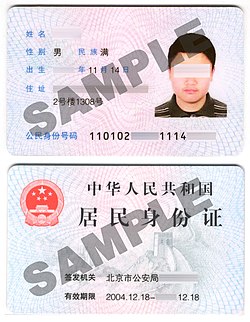This is an old revision of this page, as edited by Benlisquare (talk | contribs) at 14:17, 9 April 2009 (→Identity card number). The present address (URL) is a permanent link to this revision, which may differ significantly from the current revision.
Revision as of 14:17, 9 April 2009 by Benlisquare (talk | contribs) (→Identity card number)(diff) ← Previous revision | Latest revision (diff) | Newer revision → (diff)This is a draft copy. Please be patient in awaiting the final copy. Thank you.
TITLE: Junmin Shenfenzheng

Junmin Shenfenzheng (Chinese: 居民身份证; Hanyu Pinyin: Jūmín Shēnfènzhèng) is the official form of personal identification in the People's Republic of China.
History
Prior to 1984, citizens within the People's Republic of China were not required to obtain or carry identification in public. On April 6 1984, the State Council of the People's Republic of China passed the "Identity Card Bill", commencing the process of gradual introduction of personal identification, in the footsteps of many developed countries at the time. The first generation identification cards were single paged cards made of polyester film.
On September 6 1985, the National People's Congress Standing Committee passed the "Identity Card Bill of the People's Republic of China", which regulated that all citizens over the age of 16 apply for identification cards. From that point onwards, the Ministry of Public Security of the People's Republic of China created a unified authority responsible for the issuing and management of the ID cards. From 2003, it is reported that a total of 1.14 billion ID cards have been created in China, for a total of 960,000,000 holders. However, as a result of technological development and certain techniques made available to the civilian population, the existing cards were easy to counterfeit, opening the increasing threat of false identification.
On June 28, 2003, the National People's Congress passed the new "Resident Identity Card Law", which expanded the scope of documents issued, and allowed soldiers in the People's Liberation Army and members of the People's Armed Police to apply for special identity cards. The law also established the use of newer, second-generation cards, which are machine-readable and more difficult to forge.
Contents
The identity card consists basic information regarding the individual, such as:
- Full name
- Gender
- Date of birth
- Location of birth
- Ethnicity
- Identification number
Information stored in the identity database for biometric ID cards documents information such as work history, educational background, religion, ethnicity, police record, medical insurance status, landlord's phone number and personal reproductive history.
Identity card number
From October 1 1999, the PRC State Council approved the establishment of a citizen identification number system, and currently consists of an 18-digit code.
| 1 | 1 | 0 | 1 | 0 | 2 | Y | Y | Y | Y | M | M | D | D | 8 | 8 | 8 | X |
| Address code | Date of Birth code | Order code | Checksum | ||||||||||||||
- Address code refers to the resident's location, where administrative divisions (including cities, banners, and districts) have their own specific codes. (For example, the code for Xicheng District in Beijing is 110,102.)
Identity law
Usage of identification
Citizens within the People's Republic of China must carry identification in public at all times, compulsory from the age of 16. The identity card is the only acceptable legal document to obtain resident permit, employment, open bank accounts, obtain passport, driver licence, application for tertiary education and technical colleges, security checkpoints in domestic terminals of Chinese airports.
Recently, there have been more services that require the display of identification cards, such as at Internet cafes and certain stores.
Anti-counterfeiting measures
